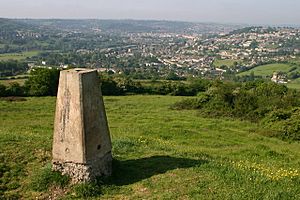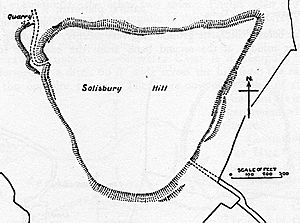Solsbury Hill facts for kids
Quick facts for kids Solsbury Hill |
|
|---|---|

Panoramic view on top of the hill
|
|
| Location | Batheaston in Somerset, England |
| Built | Iron Age |
| Reference no. | 203323 |
| Lua error in Module:Location_map at line 420: attempt to index field 'wikibase' (a nil value). | |
Solsbury Hill is a small hill with a flat top. It used to be an Iron Age hill fort, which was like a fortified village. You can find it above the village of Batheaston in Somerset, England. The hill rises about 190 meters (625 feet) above the River Avon. This river is just over 1.6 kilometers (1 mile) to the south. From the top, you get great views of the city of Bath and the area around it. Solsbury Hill is part of the Cotswolds Area of Outstanding Natural Beauty.
This hill is one of the places where the famous Battle of Badon might have happened. You can also see signs of old medieval fields on the hill. In the 1800s, part of the hill was used as a quarry. In 1930, the National Trust took care of the hill. Solsbury Hill also inspired the song "Solsbury Hill" by Peter Gabriel, which came out in 1977. In 1994, during protests about widening the A46 road, people cut a small turf labyrinth into the grass.
Contents
Understanding the Name Solsbury Hill
Sometimes, people misspell the hill's name as Salisbury or Solisbury. This might happen because it sounds similar to Salisbury Plain or the city of Salisbury. It can be hard to tell the names apart when spoken.
The name 'Solsbury' might come from the Celtic god Sulis. People used to worship Sulis at the hot springs in nearby Bath. An old map from 1888 even called the hill 'Stilisbury Hill'.
How Solsbury Hill Was Formed
The hill is made up of different layers of sedimentary rocks. These rocks were formed during the Jurassic period. The very top of the hill is made from a type of rock called Chalfield Oolite. This rock, along with another layer called Fuller's Earth, is part of the Great Oolite Group.
Below these layers are older limestones and sandstones. At the very bottom, near the valley floor, is a thick layer of mudstone. All sides of the hill have areas where the ground has slipped, known as landslips. The hill is about 190 meters (625 feet) high and sits just over 1.6 kilometers (1 mile) north of the River Avon.
Solsbury Hill as an Iron Age Fort
Solsbury Hill was an Iron Age hill fort between 300 BC and 100 BC. It was a triangular area surrounded by a single wall, called a univallate rampart. This rampart had strong dry stone walls on the inside and outside, filled with rubble. The wall was about 6 meters (20 feet) wide, and its outer part was at least 3.6 meters (12 feet) high.
People cleared the top of the hill down to the bedrock. Then, they built sturdy huts using wattle and daub on wooden frames. After some time, some of these huts burned down. The rampart was knocked over, and people left the site. It was never used as a fort again. This event might have happened during the Belgic invasion of Britain in the early 1st century BC.
Later History of the Hill
The hill is close to the Fosse Way, an old Roman Road. This road goes down Bannerdown hill into Batheaston on its way to Bath. Solsbury Hill is one possible place where the Battle of Badon took place. This battle was fought around 496 AD between the Britons, led by the legendary King Arthur, and the Saxons. Old writers like Gildas and Nennius mentioned this battle. The hilltop also shows signs of old field systems from medieval or later times.
Solsbury Hill also has two old quarries that are no longer used. One was on the northwest side, shown on a map from 1911. Another was on the west side, listed as an old quarry between 1885 and 1900. The National Trust bought the hill in 1930. In the mid-1990s, people protested against building an A46 bypass road. During these protests, they cut a small turf maze into the hill. Some people were injured during these protests.
Wildlife on Solsbury Hill

The plants and animals on Solsbury Hill live in a special grassland habitat. This grassland grows on top of limestone rock. Many unique plants and animals, some of them rare, have adapted to this type of calcareous grassland. Most of the land here has not been changed much by farming. This is shown by the presence of yellow meadow ants.
You can find plants like bird's foot trefoil, vetches, greater knapweed, harebells, yarrow, and scabious. Solsbury Hill is one of several places with many flowers that the Avon Wildlife Trust is trying to connect.
These plants attract many insects. These include the six-spotted burnet moth, hummingbird hawk-moth, and different butterflies like chalkhill blues. A small group of common buzzards (Buteo buteo) also build their nests in the area. You might also see Roe deer (Capreolus capreolus), badgers, and red foxes. Skylarks also nest on the hill.
Images for kids
See also
 In Spanish: Solsbury Hill para niños
In Spanish: Solsbury Hill para niños



